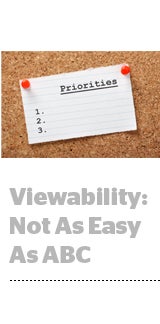 The 50% viewability standard might fly (sort of) in the US, but it’s not yet considered to be a viable currency in the UK.
The 50% viewability standard might fly (sort of) in the US, but it’s not yet considered to be a viable currency in the UK.
But UK-based media auditing body ABC – think of it as the equivalent of the Alliance for Audited Media in the US – released a report and related vendor certification Wednesday aimed at getting Team GB one step closer to an acceptable viewability standard. [Download the report.]
DoubleVerify, comScore, Integral Ad Science and Moat are the first solution providers to earn ABC’s stamp of approval for their viewability services. London-based viewability vendor OnScroll is on deck. The process, like MRC accreditation, is voluntary.
ABC put those players to the test using a set of principles created by the Joint Industry Committee for Web Standards (JICWEBS), a coalition of seven UK trade bodies, including the UK arm of the IAB, the Association of Online Publishers and the Incorporated Society of British Advertisers.
The JICWEBS didn’t pull any punches in coming up with its core principles: What percentage of an ad can a product measure? Was the content able to be seen at all? How long can the product measure and view the content in question? At what point during the rendering process does viewability measurement begin? Etcetera.
“We’re trying to encourage realism over idealism,” said Richard Foan, group executive director of communication and innovation at ABC UK. “We’re breaking down the issue into manageable steps.”
Having completed the first step of its plan – a set of principles from JICWEBS to work off of – ABC will dole out certification to those who earn it. From there, the hope is to educate the industry about what each viewability tool can actually do, thereby giving both advertisers and publishers a clearer understanding of why discrepancies exist in viewability reporting. (For example, one tool might be really handy for viewing an iFrame in a certain browser on desktop, while a different tool might be better for mobile.)
ABC will collect feedback from the trade associations in JICWEBS and meet in early December to form a plan for Q1 2015.
It’s important to note that ABC and JICWEBS are not talking about a metric – yet.
“When we’ve done all that work, maybe step three can happen – deciding on a metric,” Foan said. “It’s being discussed, but it’s still early for us.”
In other words, define your terms before opening the can of worms. But that’s not to say that ABC’s or JICWEBS’s methods are at odds with the efforts of its US counterparts, Foan said, noting that both organizations engage in an ongoing dialogue with the MRC and IAB to share learnings and experiences.”
Nonetheless, JICWEBS decided it was “probably a little early” to use the 50% standard to trade on viewability “while there are still discrepancies to consider.”
“We looked at the MRC standard that was announced in the States and decided: ‘We’ll come back to that when we have a better idea of how the tools work,’” Foan said. “We feel that first clarifying the causes and reducing the scale of the discrepancies will be a big step in the right direction in enabling standards to come through.”
Although it’s a bit premature to think about a global viewability standard, Foan said that a universally accepted number is the ultimate goal.
“Our aim is to have a global standard for local marketing, meaning a global standard that local markets can refine as they need to,” he said.
Although it’s a hot topic right now, Foan predicted that the beast will ultimately be tamed, just like what happened with the IAB’s ad impression measurement guidelines in the mid-2000s – it’s just a matter of doing the legwork.
“ABC was established in 1931 because advertisers said they wanted an independent, trusted third-party to check the claims that newspapers were making about their circulation,” Foan said. “There’s nothing new in media, there are just different names.”











